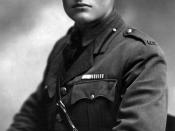Setting of Moods Ernest Hemingway?s A Farewell to Arms takes place in the early nineteen hundreds during the time of World War One. The story is told by the main character, Frederick Henry, who drives emergency ambulances in Italy. The atmosphere created in the story is generally depressing, as one would assume for it being set in a war. The use of symbolism helps Hemingway establish the setting. He uses the symbolism most in the physical sights. His main choices for his use of symbolism are rain, mountains, and plains. Hemingway?s use of symbolism to express setting is all his own style.
Rain is commonly used to show cleansing or the start of something new in many author?s books. Hemingway has an entirely different perspective on what rain represents. He uses rain to set a grimacing mood and at some instances as a foreshadower of bad news.
When Henry leaves on his journey back to the war, rain follows his departure causing an unsettling mood: ?Outside the mist turned to rain and in a little while it was raining hard. We heard raining on the roof? (Hemingway 125). The rain in this situation is used to make his departure seem more dramatic and sad. In another part of the book right before Henry and Catherine Barkley receive news that Henry was soon to be arrested, a terrible storm begins to brew outside: ?That night there was a storm. I woke up to hear rain lashing the windowpanes. It was coming through the windows? (Hemingway 264). The rain in that part of the book starts just before he receives the news and continues on. It is used as a foreshadowing of the oncoming news. Another scene that involves rain is about Barkley. It begins to rain while Barkley...


